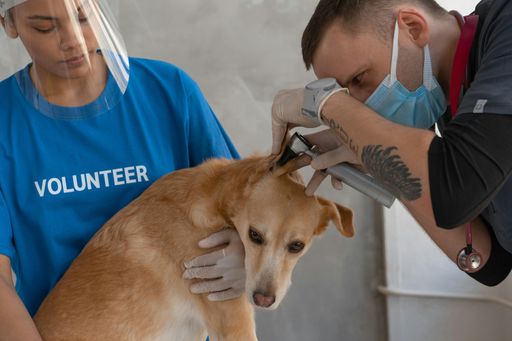If your poor dog has recently been diagnosed with diabetes it may seem daunting and it may seem like there will be a long struggle ahead for you and your pup.
Worry not, as although it does depend on the severity of the condition, it’s not all that difficult to manage but it will take long term commitment, medication and the careful management of your dog’s diet.
Diabetes affects dogs in a very similar way to how it affects humans; it’s a disorder in the biological mechanisms your body employs to manage carbohydrates resulting in a blood-sugar concentration that can get either dangerously high or low. It’s the careful management of your dog’s blood-sugar levels that is your number one priority when caring for your diabetic pooch.
What is Diabetes?
Diabetes Mellitus is the official name and as mentioned above, it’s a disorder in which the blood-sugar concentration has an imbalance which can lead to some nasty consequences. It’s all to do with a hormone that’s produced by the pancreas: insulin, which is responsible for transporting and breaking down glucose.
When your dog has eaten food, the food is dismantled by the digestive system into smaller components that the body can use. Carbohydrates from the food are made into simple sugars; one of them is called glucose.
The glucose then travels from the intestines into the blood and this is when insulin is supposed to transport the glucose to the “hungry” cells and then break down the glucose within the cell which can then be used as energy by the cell so it can go on functioning.
The symptoms and complications associated with diabetes arise when there is too little insulin to process the glucose in the blood. The glucose builds up and reaches a high concentration that is unhealthy and leads to other conditions such as cataracts.
Types of Diabetes
There are two types of diabetes: Type 1 (insulin dependent diabetes) which is the result of the body not making enough insulin and Type 2 is not only an abnormally low insulin count but also the improper formation of the insulin that is present.
Type 1 is typically the type dogs can develop while you’re far more likely to find type 2 in cats and so it is most likely your canine suffers from diabetes type 1.
How to Spot if Your Dog has Diabetes
A variety of symptoms can be exhibited by dogs which have diabetes. They may not all show at the same time so if you are suspicious your dog is ill and notice any of these symptoms, take them to your vets right away. According to WebMD these symptoms include:
- Increased Thirst
- Drinking Excessively
- Increased Urination
- Dehydration
- Change in Eating Habits
- Increased Hunger
- Vomiting
- Urinary Infections
- Lethargy
- Cataracts
- Skin Infections
- Sweet Smelling Breath
The cells receiving a lack of nutrition due to the lack of insulin being able to carry glucose into them will cause your dog to become very tired, and hungry all the time but no matter how much is eaten, little much needed nutrition actually gets to the cells.
As the blood-glucose concentration increases, hyperglycemia occurs when the diabetes goes untreated. This damages tissues, the nervous system and causes dehydration whilst also increasing the risk of infection by having a high amount of nutrition being left in the blood.
A multitude of other issues can arise from untreated diabetes such as glaucoma which can potentially lead to blindness and so it is vital to get your dog to a vet when you have the slightest suspicion.
How is Diabetes Treated
After your vet has done a physical exam and a urinary test, they will easily be able to diagnose your dog.
Upon first discovering your dog has the disease, most dogs already have a high blood-glucose imbalance and depending on how it affects your dog, as it affects individuals differently, they may need to be hospitalized to be stabilized again before they can go on and receive daily treatment.
Type 1 diabetes in dogs is usually treated with a daily injection of insulin to maintain the blood-glucose concentration at a stable level on top of daily management.
Sometimes a daily injection isn’t needed and oral medication can suffice. Whether or not the treatment is oral or intravenous, you will also need to commit to managing your dog’s illness in a variety of other ways too.
Going Forward
Managing your dog’s life after its diagnosis takes some persistence from you as the owner. It doesn’t have to be all doom and gloom, you just have to take several steps and precautions to ensure your canine companion enjoys a long, happy and fulfilling life.
Medication and Veterinary Appointments
First of all, make sure you follow all the vets’ instructions and if your pet has medication that’s either daily or weekly, make sure that they get the right dosage, exactly on time. Your vet will guide you on when and how to do this so you won’t be all on your own.
There will probably also be multiple follow up tests with your vet, just to check how your dog is getting on and how they are responding to the medication. These check-ups are absolutely vital in order to calibrate the exact amount of medication your pet needs and will ensure they are as healthy as possible.
Lifestyle and Routine
Your dog is going to need to change its lifestyle if it isn’t already following the recommended actions and that means regular exercise and a strict diet!
Ask your vet about the right diet for your dog specifically. Some of the best diabetic dog food will usually involve low glucose, low fat and high fibre kibble mixes and you may be trialling different brands with your dog until they take to the one they like but try to be as consistent with their diet as possible.
As for exercise; it’s absolutely important to avoid a lot of the negative impact diabetes can have on your dog’s body. Walking and playing on a regular basis would be all that it needs and using a Fitbark would be just the device that you can use to monitor your dog’s daily progress and to help you tailor the exercise routine that’s right for them.
Be Vigilant
Be sure to keep an eye on them from time to time. Monitor their symptoms so you can get to know when they are displaying a high blood-glucose level or even a high insulin level. If insulin is too high, this can also be dangerous so if this is the case be sure to talk to your vet about altering the dosage.



















